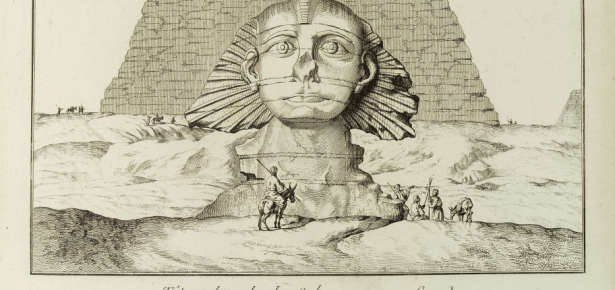
Credit: Wellcome Library, London
Later arrivals – whether as visitors or conquerors – were simply awed. Even the greatest egoist of all time, Napoleon, was impressed enough to take a whole scientific expedition in his baggage train when he set out to conquer the country; and to exhort his troops to be mindful of the forty centuries of history looking down on them at the battle of the Pyramids. (Or is this a myth too? The site of the battle was nine miles from Giza, so the pyramids, enormous as they are, couldn’t have done much actual looming.)
As mentioned before, the defeat of Napoleon, combined with the various publications of his scientists, led to a surge of interest in Egypt, and a great deal of unscientific and amateur digging for treasure at various sites, but also to some more careful surveys and excavations by people who perhaps deserved to be described as ‘Egyptologists before Egyptology’, or at any rate before its ‘Father’, Flinders Petrie.
The other thing, of course, which triggered a massive leap forward in the understanding of the ancient civilisation was the decipherment of the hieroglyphs and rediscovery of the Egyptian language – whether you want to give the primacy to Britain’s Thomas Young or France’s Jean-François Champollion.
I have been looking at the books we have on travels in Egypt before Amelia Edwards‘s first visit in 1873, and there is a surprising number already reissued or in process. I’ve mentioned before the circus artist and (so he claimed) hydraulic engineer, Giovanni Battista Belzoni.
At about the same time, Henry Salt (1780–1827) abandoned his hopes of becoming a portrait painter and instead entered the employment of Viscount Valentia, embarking with him on an eastern tour in 1802.
In 1805, Valentia sent Salt on a mission to improve relations with the rulers of Abyssinia. After a second expedition, this time on behalf of the British government, in which he made observations and collections of the local flora and fauna, he was appointed consul-general to Egypt, and in his spare time carried out excavations at Thebes and Abu Simbel.
Salt’s close friend, the painter J. J. Halls, published a two-volume biography in 1834. His factotum, Giovanni D’Athanasi, also produced an account of his master’s life and excavations, together with a list of the items in his massive collection of antiquities, many of which found a home in the British Museum.
Hall also edited the memoirs of another of Salt’s servants, Nathaniel Pearce, who led an extremely rackety life until he fetched up in Egypt, accompanying Salt’s 1805 and 1810 journeys, and marrying a local girl in Tigré, where he remained, serving the local ruler until the latter’s death in 1816. Pearce’s humorous account of his life is particularly interesting in the details it gives of the land and people of Ethiopia, then little known by Europeans. It ends abruptly in 1820, when Pearce was on the point of returning to England, but died of a fever in Alexandria while waiting to embark.
Meanwhile, a retired British military man, Richard William Howard Vyse (he added the ‘Howard’ to secure a bequest), had visited Egypt and become interested in the excavations at Giza. He financed and took part in excavations near the pyramids, and later supported the work of his associate John Shae Perring at Abu Rawash, publishing his finding in the three-volume Operations Carried On at the Pyramids of Gizeh in 1837, in 1840–2.
Other visitors at the time included Charles Irby and James Mangles, naval officers and later brothers-in-law: they went up the Nile with Belzoni, and recorded their adventures in Travels in Egypt and Nubia, Syria, and Asia Minor, during the years 1817 and 1818 (published in 1823, and coming soon).
The popularity of travel to Egypt, not merely for the sights but also because of a dry warm climate thought to be beneficial for lung diseases, led to a growth in guide-books, to the country and people as well as to the archaeological sites. One of the earliest was provided by John Gardner Wilkinson, who had planned to join the army once he had finished his Grand Tour. However, while in Italy, he fell in with Sir William Gell, who persuaded him to use his interest in antiquity and artistic skill to do some serious work in Egypt.
Wilkinson arrived in 1822, was entranced, and spent the next twelve years excavating. In 1835 he published his Topography of Thebes, and General View of Egypt (above), which was followed in 1837 by the three-volume Manners and Customs of the Ancient Egyptians, and in 1843 by Modern Egypt and Thebes: Being a Description of Egypt, Including the Information Required for Travellers in that Country, in two volumes.
He wrote the Murray’s Guide to Egypt, first published in 1847, which continued in new editions long after his death in 1875, and his travels in the Mediterranean area also led to the two-volume Dalmatia and Montenegro of 1848. Alas, his final book, on the desert plants of Egypt, was never published: a prospectus was sent out by his widow, Caroline, a botanical author in her own right, but the work failed to appear, and the writings and drawings on which it was based have vanished from the valuable collection of his papers in the Bodleian Library. But while Petrie is the undoubtedly the Father, Wilkinson has a very good claim to be the Grandfather of Egyptology.
Latest Comments
Have your say!